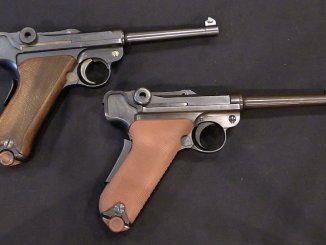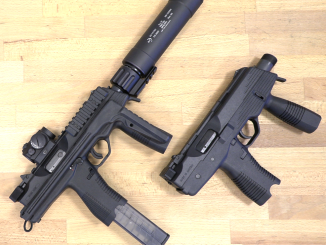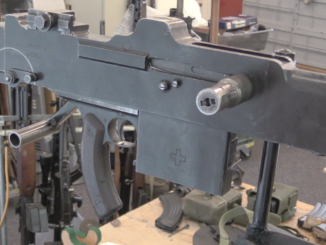Rico is a gunsmith at SIG Neuhausen who likes to tinker. He put together this SIG 510 (aka Stgw 57), with a modern collapsing stock, quad rail foreend, Aimpoint red dot, heavy barrel, and massive muzzle brake. And we just happen to have some 7.5 Swiss and a full-auto grip assembly. How hard can it be?
Thanks, Rico!




You checked for empty in the wrong order. You checked your chamber first, then pulled your magazine. I know you know the correct order as I’ve seen you do it countless times in your videos but someone watching may not know that. Great video otherwise. Love the recoil control.
Good Morning Ian.
Impressive muzzle flash, however, consider a Thompson Center ‘Contender’ with a 10 inch barrel, chambered in .30-30 Winchester, firing a factory 170 grain load.
Sitting at a shooting bench at a local gun store’s private range,
there was about a 10 foot diameter muzzle flash which picked up loose .22 brass from the ground and scattered it around, lifted the tin roof and loosened bird feathers and bird poop which fell on the shooters.
Using hand loads, with RE-7 & 150 grain spitzer bullets, easily tamed
the T-C..
“Thompson Center ‘Contender’ with a 10 inch barrel, chambered in .30-30 Winchester, firing a factory 170 grain load.”
Taking in account it is rifle cartridge, it is not wonder that it has not enough time to burn in much shorter barrel. This apply also to other cartridge created for long barrel in short barrel, for example .30 Carbine in automatic pistol or revolver also can give serious flash. On extreme end of flash generating is probably THUNDER non-automatic magazine-less pistol: http://gearsofguns.com/50-bmg-thunder/
which fire 12,7×99 NATO cartridge.
My friend & I were new to the Thompson Center Contender and had not considered the burn time of the slower rifle powders. We found out VERY quickly!!
The recoil was tremendous as well.
When I reloaded with RE-7 & 120gr bullets, everything worked out well.
I also found a load for RE-7 with 125 gr jacketed HP bullets for use in my Winchester .30-30 carbine. Groups tightened considerably and recoil was much less.
Apparently the factory .30-30 loads were really designed for rifles, not for carbines.
A friend with a Savage 99 liked the RE-7 reloads for deer hunting.
What muzzle brake is that exactly? Looks like fun
On the other end of the spectrum, the Japanese Type 38 long rifle has little to no muzzle flash at all. The Type 97 Sniper Rifle has even less and if I’m not mistaken, nobody wants to get 6.5 x 50 SR Arisaka through the liver. I saw a bullet penetration demonstration of the Type 44 cavalry carbine with reloaded brass cartridges (on YouTube). The jacket and the core separated between water jugs, with the lead core going at least one jug further than the copper jacket. I would HATE to imagine getting sniped with such a projectile…
This performance is typical of the 6mm and 6.5mm military rounds, be they Japanese, Greek, Swedish or whatever. The reason is apparently the bullets’ greater length-to-beam ratio compared to other typical calibers, notably the 7.62mm to 7.9mm range.
When they impact and penetrate, they generally begin turning end-over-end and do not restabilize, creating a wound channel reminiscent of a bayonet thrust, twist, and withdraw. If they hit bone, they tend to shed the bullet jacket and fragment. Sometimes, on sufficiently deep penetration, the jacket separation and core “burrowing” you saw occurs.
Oddly enough, this seems to be due to their generally arriving at somewhat lower velocity than most .30 cal. or .223 caliber-class projectiles. At .223 velocities, they would probably “blow up” and crater on impact, as was often seen with the old 6.5mm Remington Magnum with bullet weights under 120 grains.
The best overall bullet weights for these rounds seem to be in the 130 to 160 grain range. It is these bullet weights, especially the 139 grain, that give the 6.5 x 55mm Swedish Mauser round downrange ballistics that almost exactly duplicate those of the approximate same bullet weights in the .270 Winchester at ranges from 200 to 400 yards. They also generate the optimum wound ballistic performance. Most military 6.5mm loads use bullets in the 140 to 160 grain range.
Incidentally, regarding 6.5mm penetration, the so-called “magic bullet”, CE399, in the JFK assassination, that the Warren Commission claimed went through the President’s neck and hit Gov. Connally isn’t all that magical. My uncle, Lt Col. U.S. Army Corps of Engineers, North Africa and Italy 1942-45, saw that sort of “Quigley” numerous times with the Italian 6.5mm Carcano rifles. And the Army Medical Corps doctors cursed the designer of that rifle and its bullets due to the damage they inflicted on whoever they hit. The JFK and Connally pathology reports looked very familiar to my uncle, and any military doctor who had served in that theater. Not to mention another of my uncles, and my old boss, who served in the PTO, or any military doctor who had encountered the Japanese version on Guadalcanal and elsewhere.
This is the main reason I tend to believe the Warren Report. The reported performance of the rifle and cartridge in question tracked almost exactly with their observed ballistic performance on the battlefields of World War Two, two decades earlier.
cheers
eon
“(…)Type 38(…)Type 97(…)”
According to http://www.lonesentry.com/articles/ttt09/smokeless-power.html
It is true that Japanese weapons*, particularly small-arms, give less muzzle flash than our weapons [U.S. weapons] of similar bore. The cause can be found by examining the relative ballistic properties of guns and ammunition of the two countries. In general, the power (velocity and weight of projectile) of the Japanese weapons are very much less than our own. At the same time these weapons have appreciably longer barrels which makes them heavier. Both conditions, low power and long gun barrels, tend to make the control of muzzle flash comparatively easy. It may, therefore, be said that Japanese small-arms are actually less effective than U.S. weapons, except for the single item of flash.
(…)
At present we prefer and actually employ superior effective fire power with greater range and velocity, even though these superior qualities are obtained at a cost of somewhat more flash.
Well, the issue not addressed is which qualities are required for which missions. Muzzle flash doesn’t matter too much if we’re putting soldiers into a prolonged battle from behind cover. Snipers, however, don’t like getting spotted, especially if their intended victims have access to machine guns, mortars, or radios (for calling down artillery).
“Snipers, however, don’t like getting spotted, especially if their intended victims have access to machine guns, mortars, or radios (for calling down artillery).”
Wait. Now I confused. I always though standard procedure (at least for Soviet snipers during Great Patriotic War) was to find good place, wait till relevant target appear, hit said target and then fast abandon this spot. Which mean that it is crucial to avoid being spotted before firing, but of little value after that.
Love the 7.5×55 round
I recall that the projectile for the Swiss ammunition is actually 7.62 mm in overall diameter. The 7.5 mm designation refers to the nominal rifle bore diameter, right?
It’s the diameter measured across the lands, while 7.62mm is the diameter measured across the grooves. You see the same thing with the French 7.5 x 54 MAS round. Both “7.5mm” rounds, like the 7.62 x 51mm NATO or its parent .300 Savage and 7.62 x 63mm (.30-06) rounds, use .308″ bullets.
This was why it was simple for the Swiss to make export versions of their “7.5mm” rifles in 7.62 x 51mm, or for the French to change over their AAT-52 and other MGs in 7.5 x 54 to 7.62 NATO in the 1980s. All they really needed to do was make new barrels with the same bore spec but with 7.62 x 51mm spec chambers.
Back in the American Civil War, the British M1853 Enfield rifle-musket was called a .577, while the American M1858 Springfield was called a .58. In actuality, their bore specs were identical; the British measured across the lands, the Americans across the grooves. Both used nominal .575″ Minie’ bullets that were expanded into the rifling by the powder burning pressure, so their bullets were completely interchangeable.
As Holmes would say, a difference, which makes no difference, is no difference.
cheers
eon
There are several ways to control muzzle flash.
To produce a flash requires
1)gasses which will burn when they encounter air
2)sufficient heat to ignite the mixture
Take either of those two necessary conditions away and you won’t get flashes.
The gasses can either be rendered less flammable by oxidising the carbon monoxide (a stoichiometric mixture of nitro glycerin and nitro cellulose will do that, and something like ammonium carbonate can be used to compensate for the reduction in gas molecules and Increase in flame temperature.
Or the carbon monoxide can be diluted by nitrogen from Nitro guanidine.
Cooling the emerging gas can be achieved by a more favourable balance between bore and case volumes to reduce gas pressure and hence temperature at the muzzle.
Or by adding salts which cool the gasses, such as ammonium carbonate.
Onice the gas is out, it can be quenched to prevent it from igniting, with structures that perform like the wire gauze does in a miners flame safety lamp.
There is also option of using flash hider, like for example in 6П62 hand-held machine gun firing 12,7×108 cartridge: http://russianguns.ru/?p=3361
“There are several ways to control muzzle flash.”
So-called flashless propellant for usage in naval guns are described here:
http://www.navweaps.com/index_tech/tech-100.php
Tactical-modding an STGW-1957 is basically the approach of making it look like SIG’s AR-15 copies without spending heavy sums of money.